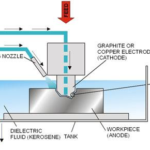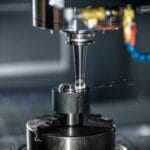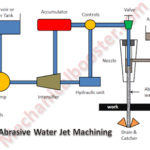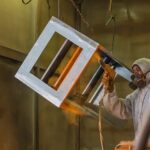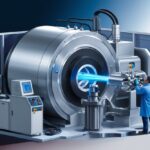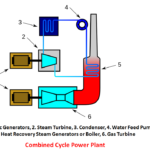Ultrasonic Machining (USM) is a non-traditional machining process that utilizes high-frequency ultrasonic vibrations combined with an abrasive slurry to remove material from a workpiece. It is particularly useful for machining hard and brittle materials like ceramics, glass, and semiconductors, where conventional methods may be ineffective. This blog explores the working principle, components, advantages, limitations, and applications of USM in various industries.
What is Ultrasonic Machining (USM)?

Ultrasonic Machining (USM) is a non-traditional machining process that uses high-frequency ultrasonic vibrations combined with an abrasive slurry to remove material from a workpiece. It is particularly effective for hard and brittle materials like ceramics, glass, and semiconductors, where conventional machining methods may not be suitable.
Comparison with Traditional Machining Methods:
- Unlike milling or turning, USM does not involve rotating cutting tools.
- Generates no heat-affected zones, unlike laser or plasma cutting.
- Effective for brittle materials where conventional methods fail.
- Can produce complex and intricate geometries with high precision.
Components of an Ultrasonic Machining (USM) System

An Ultrasonic Machining system consists of several key components that work together to achieve precise material removal through high-frequency ultrasonic vibrations and abrasive slurry. Here’s a detailed breakdown of each component:
1. Ultrasonic Generator
The ultrasonic generator is the power source that converts standard electrical energy (AC power) into high-frequency electrical signals.
Function:
- Generates ultrasonic vibrations at frequencies typically ranging from 20 kHz to 40 kHz.
- Controls the vibration amplitude and frequency for consistent material removal.
Importance:
- Ensures stable and uniform energy delivery to the transducer.
- Helps regulate the power intensity for different materials and machining conditions.
2. Transducer
The transducer is responsible for converting the electrical signals from the generator into mechanical vibrations. It is made of piezoelectric or magnetostrictive materials that expand and contract when exposed to an electric field, producing mechanical oscillations.
Function:
- Transforms electrical energy into mechanical energy (vibrations).
- Ensures consistent amplitude and frequency of vibrations.
Types of Transducers:
- Piezoelectric Transducer: Uses piezoelectric crystals (quartz or ceramics) to generate vibrations.
- Magnetostrictive Transducer: Utilizes ferromagnetic materials (e.g., nickel) that deform under magnetic fields, creating oscillations.
3. Tool Horn (Booster)
The tool horn, also called the booster, amplifies and transmits the ultrasonic vibrations from the transducer to the tool. It plays a crucial role in enhancing vibration intensity.
Function:
- Amplifies the vibration amplitude.
- Directs mechanical vibrations to the tool tip.
- Improves machining efficiency by delivering consistent force.
Material:
- Typically made of titanium or aluminum to withstand vibrations without significant wear.
4. Tool (Sonotrode)
The tool, also known as the sonotrode, is the part of the system that directly interacts with the workpiece. It shapes and removes material through repeated abrasive impacts.
Function:
- Transfers ultrasonic vibrations to the abrasive slurry.
- Machining is performed by micro-chipping the surface of the workpiece.
- Defines the shape and accuracy of the final machined product.
Material:
- Made of tough, wear-resistant materials like stainless steel, tungsten carbide, or titanium.
- The shape of the tool corresponds to the desired cavity or feature on the workpiece.
5. Abrasive Slurry
The abrasive slurry is a mixture of fine abrasive particles suspended in a liquid (usually water or oil-based fluid). It plays a vital role in material removal through erosion.
Function:
- The slurry particles impact the workpiece due to ultrasonic vibrations, causing micro-chipping and abrasion.
- Improves machining accuracy and surface finish.
Common Abrasive Materials:
- Silicon Carbide (SiC) – Ideal for machining hard ceramics and glass.
- Boron Carbide (B4C) – Used for high-strength materials.
- Aluminum Oxide (Al2O3) – Suitable for moderate hardness materials.
6. Workpiece (Material Being Machined)
The workpiece is the material being machined by the USM process. USM is highly effective for hard and brittle materials, which are difficult to machine using traditional methods.
Common Workpiece Materials:
- Ceramics – Alumina, zirconia.
- Glass and Quartz – For optical components.
- Semiconductors – Silicon wafers.
- Hard Metals – Carbides, hardened steel.
- Composites – Fiber-reinforced materials.
7. Cooling and Flushing System (Optional)
Some advanced USM systems include a cooling and flushing system to prevent overheating and remove waste material.
Function:
- Flushing nozzles supply a continuous flow of abrasive slurry.
- Removes debris and heat from the machining area.
- Improves surface quality and tool longevity.
Working Principle of Ultrasonic Machining (USM)

The working principle of Ultrasonic Machining (USM) revolves around the erosion of material through high-frequency ultrasonic vibrations combined with the abrasive action of a slurry. Unlike conventional machining, USM relies on mechanical impacts caused by vibrating tool tips and abrasive particles rather than direct cutting.
Step-by-Step Working Process of USM
1. Generation of Ultrasonic Vibrations
The process begins with the ultrasonic generator, which converts standard electrical energy (AC power) into high-frequency electrical signals.
- The generator typically produces frequencies ranging from 20 kHz to 40 kHz.
- These high-frequency electrical signals are then transmitted to the transducer.
Purpose: To create a consistent source of ultrasonic energy for material removal.
2. Transmission of Vibrations to the Tool
The transducer (piezoelectric or magnetostrictive) receives the electrical signals and converts them into mechanical vibrations.
- These vibrations are then directed towards the tool horn (booster).
- The tool horn amplifies the vibrations and directs them to the sonotrode (machining tool).
- The amplified vibrations cause the tool to oscillate at ultrasonic frequencies.
Purpose: To transfer and enhance the vibration amplitude for effective material removal.
3. Introduction of Abrasive Slurry
A mixture of fine abrasive particles suspended in a liquid (typically water) is fed into the machining area.
Common abrasive materials include:
- Silicon carbide (SiC) – Suitable for ceramics and glass.
- Boron carbide (B4C) – Ideal for machining harder materials.
- Aluminum oxide (Al2O3) – Used for moderate hardness materials.
The slurry flows continuously, ensuring that fresh abrasive particles are always available for material removal.
Purpose: The abrasive slurry plays a critical role in micro-chipping and erosion of the workpiece.
4. Material Removal Through Micro-Chipping
The actual machining process occurs due to the combined action of ultrasonic vibrations and abrasive slurry.
- The tool oscillates at ultrasonic frequencies (around 20,000–40,000 cycles per second).
- The abrasive particles suspended in the slurry strike the workpiece repeatedly.
- This results in micro-chipping, erosion, and fracture of the material surface.
Key Characteristics of Material Removal:
- No direct tool-workpiece contact – Reduces tool wear.
- Cold machining process – No heat-affected zone (HAZ).
- High precision and intricate detailing – Ideal for delicate and complex shapes.
5. Flushing and Cooling
During the machining process, the abrasive slurry removes the eroded material particles from the machining area.
- Continuous flushing ensures that new abrasive grains reach the work surface.
- Flushing also helps in cooling the system, preventing overheating.
Purpose: To maintain machining efficiency by removing debris and keeping the temperature stable.
Key Factors Affecting the Working Principle
The efficiency and accuracy of the USM process depend on several factors:
- Frequency of Vibrations:
- Higher frequency increases material removal rate (MRR) and precision.
- Abrasive Slurry Type and Size:
- Finer abrasives produce a smoother surface finish.
- Coarser abrasives lead to faster material removal but rougher surfaces.
- Amplitude of Vibrations:
- Higher amplitude improves machining depth but may reduce accuracy.
- Tool Shape and Material:
- The tool material must be wear-resistant for consistent performance.
- Workpiece Hardness:
- USM is most effective on hard and brittle materials like ceramics, glass, and quartz.
Types of Ultrasonic Machining
- Conventional Ultrasonic Machining (USM) – Uses a vibrating tool and an abrasive slurry for localized material removal.
- Rotary Ultrasonic Machining (RUM) – Combines rotational motion with ultrasonic vibrations for higher efficiency and faster material removal rates.
- Hybrid Ultrasonic Machining – Integrates USM with Electrical Discharge Machining (EDM), Laser Machining, or CNC to improve precision and cutting speed.
Advantages of Ultrasonic Machining
- Ideal for Hard & Brittle Materials – Works efficiently on ceramics, glass, quartz, and composites.
- No Thermal Damage – Unlike laser machining, USM generates minimal heat, preventing workpiece distortion.
- High Precision & Accuracy – Can produce intricate shapes, micro-holes, and delicate features.
- No Direct Tool-Workpiece Contact – Reduces tool wear and mechanical stress, extending tool life.
- Minimal Chemical Alteration – Maintains the original chemical and mechanical properties of materials.
- Can Machine Fragile Materials – Prevents cracking or chipping in delicate materials.
Disadvantages and Limitations of USM
- Slow Material Removal Rate (MRR) – Compared to traditional machining, USM is relatively slow, making it less suitable for bulk material removal.
- Limited to Brittle Materials – Not effective for soft and ductile metals that deform rather than break.
- Higher Initial Cost – USM setup is expensive due to its high-precision components.
- Limited Machining Depth – Depth is restricted by tool vibration limits, affecting deep drilling applications.
Applications of Ultrasonic Machining
- Aerospace Industry – Used for drilling holes and shaping components in ceramic and composite materials.
- Electronics Manufacturing – Machining of microelectronic components, semiconductors, and circuit boards.
- Medical Industry – Producing precise surgical tools, orthopedic implants, and biomedical devices.
- Automotive Industry – Precision machining of engine components, fuel injectors, and braking system parts.
- Defense & Military – Used for machining high-strength materials for armor, optics, and weaponry.
Future of Ultrasonic Machining
- Hybrid USM Technologies – Integration with EDM, laser, and CNC machining for improved performance.
- AI & Automation – Smart ultrasonic systems with real-time process monitoring and control.
- Nano-Machining & Micro-Fabrication – USM is being adapted for nano-level precision in advanced manufacturing.
- Sustainable Machining – Research on eco-friendly abrasives and lower energy consumption to enhance sustainability.
- Industry 4.0 Integration – IoT-enabled smart USM systems that offer predictive maintenance and efficiency tracking.
Conclusion
Ultrasonic Machining (USM) is a critical non-traditional machining process that enables the precision shaping of hard and brittle materials. Despite its slow material removal rate, its ability to provide high accuracy, minimal heat damage, and intricate detailing makes it indispensable in aerospace, electronics, and medical industries. With continuous technological advancements, USM is set to become more efficient and widely adopted in high-precision manufacturing.

